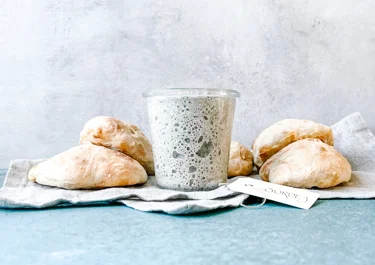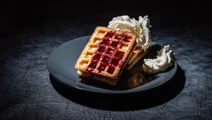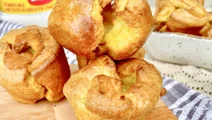
Sourdough

Instructions
Day 1
Day 3
Day 4
Day 5
Tips
Make sure the water is no more than 30 °C when you mix it with flour, otherwise this can kill the good bacteria.
Tips
Put an elastic band around the glass to mark the start level and keep track of how much it is rising. We recommend using your fingers for mixing because the natural bacteria on your fingers can help activate the starter. If it has not doubled in volume after 3-5 hours on day 5, let it sit for another day and feed it again.
Tips
The sourdough starter consists of living bacteria, which work differently and makes it difficult to set fixed times for how it will develop. You can help the process by using warmer water at around 28-29°C and storing the starter in a warm place. When it has risen and developed air bubbles on the side of the glass as well as a sweet and lightly sour smell, it is a sign that it is active and ready for use.
Tips
Remember to take about 50 g of sourdough starter from the jar before baking. There will always be some leftovers that must be discarded in the process. Otherwise, you end up with a considerable amount of dough.
Tips
If the sourdough starter develops a pink or orange tinge on the surface, it is a clear sign that it has gone bad, and you need to toss it immediately. Clean the glass jar or container thoroughly and start over. You can also smell it; if it smells like rotten fruit, discard it right away.
Tips
If you need more recipes, you can take your favourite recipe for regular bread and convert it into sourdough bread. Just remember that you are not only adding yeast, you are also adding water, flour, bacteria and their acids, and much more, so you cannot convert it 1:1. Use, for example, our recipe for Danish rye bread but substitute the yeast – 25 grams – with about 150 grams depending on how much flour and water the bread has and how much there is in the starter, too. Try it out and change the amount each time until you have the perfect sourdough rye bread. In the case of rye bread, it does not have to be that active; it is more important to have a slightly older one with a higher amount of acetic acid.
Questions about sourdough
Making sourdough at home almost feels like you are conducting a little science experiment with a lot of steps and pitfalls. Luckily, we have provided you with the necessary instructions and information to succeed; all you need is a little patience and a few basic ingredients. Read below and learn more about making a sourdough starter.
A sourdough starter is a leavening agent that makes baked goods rise and contains fermented water and flour. This creates the perfect conditions to cultivate lactic acid bacteria and naturally occurring yeast that feed on the carbohydrates in the flour and water. The starter needs to be continuously fed to release gases that provide air and lift when baking bread and pastries.
Making a sourdough starter is pretty straightforward, as you only need water and two types of flour. Stir water and flour together in a glass jar and cover it with a piece of cloth. Let the starter sit at room temperature for 2 days before continuing to feed it regularly with water and flour on days 3, 4, and 5. This will keep the starter active and alive and provide your baked goods with enough rise and air.
Once the sourdough starter has had time to sit for 2 days, you can start feeding it with water and flour. Remove the crust, take 50 g out, and put it in a jar with water and flour. Stir the mixture until there are no lumps and cover it with a cloth before letting it sit at room temperature again. Repeat the process on days 4 and 5. Once it has doubled in volume after feeding it on the fifth day, it is ready for baking.
It is best to use the sourdough discard right away. If the discard is left for too long, it will affect the quality and flavour and give the baked good an unpleasant taste. Store the discard at room temperature for up to 2 days or put it in an airtight container and refrigerate it for about 1-2 weeks. When you are ready to use it, bring the discard to room temperature before baking.
There is no need to throw away your sourdough discard when you can make perfectly delicious recipes with it. Use it to make a variety of different treats, for example, pancakes, flatbread, waffles, or cake. As the discard no longer has the same potential to rise, you need to pair the discard with another leavening agent, such as baking powder or soda, which will often already be a part of the recipe you use when adding the sourdough discard. It will give an additional boost, and you will get an extra fluffy and airy result.
Yes, you can freeze sourdough starter, but it is important to note that some of the yeast and bacteria that make your baked goods rise die off during freezing. To protect and maintain the balance of good bacteria and yeast, you have to prepare it for freezing. A mature starter that is at least a few months old is better suited for freezing as lactic acid bacteria and yeast have a higher chance of survival, making it easier to revive it when defrosting it. The easiest way to freeze the starter is to portion it into the amount you typically use for baking. Put these portions in freezer bags or freezer-safe jars and place them in the freezer.
With a little love, you can revive the ailing sourdough starter by doing regular feedings. Take it out of the fridge and let it sit at room temperature for a couple of hours. Stir the mixture to ensure that everything is reincorporated and start the feeding process. Discard some of it, add fresh flour and water, let it sit and repeat the process until it shows signs of activity.
Ingredients
Day 1
|
Lukewarm water
|
150 ml |
|---|---|
|
Wheat flour
|
100 ml |
|
Rye flour or another type of coarse flour
|
100 ml |
Days 3, 4, and 5
|
Sourdough
|
50 g |
|---|---|
|
Lukewarm water
|
50 ml |
|
Coarse rye flour
|
50 g |
Sourdough starter – start your sourdough baking right here
Forget store-bought bread and pastries; this is the real deal! With our sourdough starter recipe, you can experience the delights of fluffy and airy baked goods with loads of flavour. You can get sourdough bread with the characteristic crispy crust, soft inner, and huge air bubbles – and of course the irresistible sour flavour that goes well with almost any topping and spread.
It is simple and easy – all you need is water, flour, and a little patience. Get your ingredients ready, find a clean glass jar and start mixing.
How to bake with sourdough starter
Before you can bake with the starter, you need to discard some of it and feed it with flour and water. Once it expands and produces air bubbles, it is ready to be put to use. You can also smell it; if it smells acidic like buttermilk, it is ready. The starter functions as a leavening agent, allowing bread and pastries to rise. So, if you are making bread, simply use your alive, bubbling, and ready-to-use starter and get started on, for example, this delicious sourdough bread with a crispy crust.
Choosing the right flour
With the right conditions and lots of patience, your starter will eventually come alive, and you can get away with using most types of flour. Some flours have less rise but more flavour. To get the best result, it is a good idea to try different types so you can experiment with taste, aroma, and consistency and find the perfect balance of flavours and textures. Our recipe for sourdough starter contains rye flour and whole wheat flour. Rye flour ferments quickly and has a moist texture and a fruity flavour, and in addition, it has more natural bacteria, making it ferment quicker, while whole wheat provides a denser texture with complex flavours.
Do you want it more or less sour?
Want to ramp up the sour? Increase the acids depending on your personal taste. You can do a few things to increase the sourness. You can, for example, feed the starter less and starve the bacteria and yeast, thereby allowing the sourdough starter to produce hooch, a liquid that collects on top of the starter when it has not been fed for some time. But the easiest way to increase the sourness is to let the starter ferment longer than you normally would, creating more acetic acid, which you, among others, know from vinegar.
Sourdough does not have to be that sour. Remember to feed the starter regularly, do not allow it to produce hooch, and shorten the time that it ferments. In reality, you have to do the opposite of what is described above to make the sourdough starter less sour.
A good rule of thumb is to know it by the smell. When it is young and fresh, it smells like buttermilk, and when it is older and more fermented, it will smell like vinegar and even alcohol.
Make use of the sourdough discard
Why toss leftover starter when you can put it to good use? If you use the discard right away, it will still be active and bubbly. However, if you store it for later use, it will be less active and not give a good rise. But rest assured, you can simply pair it with baking powder and soda and still get an airy and fluffy result.
If you use it as is after discarding, you can simply add it to most recipes, taking into account how much flour and water you add since this is already a part of the sourdough discard. Simply put, divide the amount of starter in two, then deduct this from the amount of flour and liquid in the recipe. For example, use our recipe for American pancakes. If you have 100 grams of sourdough discard, only use 250 grams of flour and about 250 grams of milk (since the recipe opts for 300 ml of milk). Make the recipe as is without changing anything else but the amount of flour and milk and adding starter. You will still get risen, beautifully fluffy American pancakes but with a more complex flavour.










